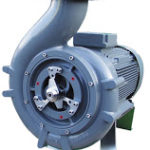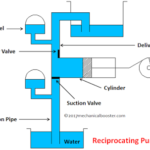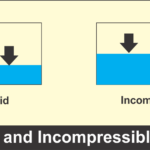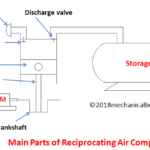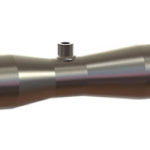Positive displacement pump (PDP) is a type of pump in which a moving fluid is captured in a cavity and then discharges that fixed amount of fluid. The displacement of fluid takes place by some parts like plunger, piston, diaphragm etc. some of these pumps have expanding cavity at the suction side and a decreasing cavity at the discharge side. The liquid is sucked at the inlet side when the cavity expands and discharges it when the cavity decreases.
In order to understand it more clearly, let’s take a syringe which has a piston inside it. When the piston is drawn outward the cavity starts expanding and water starts to enter into the syringe cylinder. As the piston is pressed inward the cavity keeps on decreasing and the liquid inside the syringe experiences a force that makes the water to escape out of the syringe. So what is the conclusion of the illustration? We have seen in that the water is displaced from the syringe during suction and discharge stroke of the piston.
Types
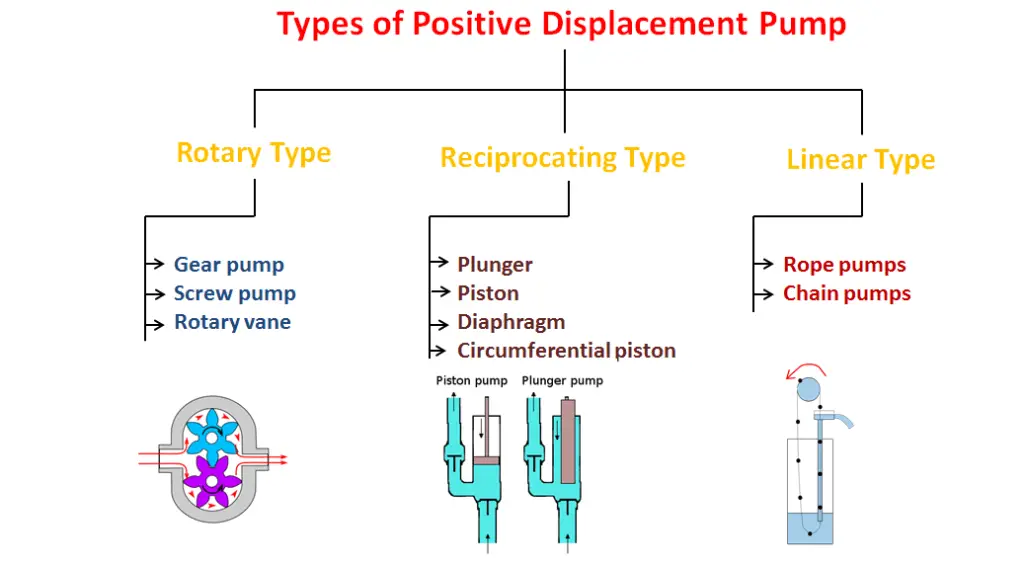
By considering the mechanism used to move the fluid it is divided into three major types
1. Rotary Type Positive Displacement
2. Reciprocating Type Positive Displacement
3. Linear Type Positive Displacement
Let’s discuss each one of them in detail
Also Read:
- Different Types of Pumps Used in the World
- What is Reaction Turbine – Principle, Working, Main Components and Application
- Types of Wind Turbines – Horizontal Axis and Vertical Axis Wind Turbines
1. Rotary-Type Positive Displacement Pump
In this pump the fluid is moved by the use of a rotary part. It is the rotation which displaces the fluid from reservoir to the discharge pipe. The common example of these types of pumps are: internal gear, screw pump, flexible vane or sliding vane, flexible impeller, circumferential pump, helical twisted roots etc.
The rotary type positive displacement pumps can be classified again into three main types
1. Gear pumps: In this pump, the fluid is moved in between two rotating gears. The liquid is
pushed between these two gears as it rotates.
2. Screw pumps: These pumps consist of two screw type rotor turning against each other. When the two
screw rotates it sucks the water from the inlet and pump it to the outlet.
3. Rotary vane pumps: It is similar to scroll compressors. It consist of cylindrical rotor having vanes on it which is encased in a similar (i.e. cylindrical type) shaped housing. When it rotates the vanes on the rotor traps the fluid in between the rotor and casing and discharges it through outlet.
2. Reciprocating Types Positive Displacement Pump
In these pumps, there is a reciprocating part (which moves backward and forward) to pump the water. The reciprocating parts may be of plunger, piston or diaphragm type. It contains valves, inlet valves and outlet valves. The inlet valves open and outlet valves remain closed during suction of liquid. And inlet valves remain closed and outlet valves gets open during discharge of the liquid.

As shown in the diagram above, as the piston moves to the right, the cavity expands and the water is sucked into it. And when the plunger moves to the left, it pushes the liquid which makes the discharge valve opens and water starts discharging through the cavity.
- Some reciprocating pump has an expanding cavity at inlet side and a decreasing cavity at the outlet side. The Liquid is sucked into the cavity as it expands and discharges when the cavity starts decreasing.
- The reciprocating pump’s category ranges from simple (with one cylinder) to Quad (four) or even more. Most of their types have duplex (two) or triplex (three) cylinder.
- It can powered by manually, by steam or air, or through a belt driven by an engine.
- It is most commonly used in 19th century as boiler feed water pump. Now days it is used to pump highly viscous fluids like heavy oils and concrete, and also used in special applications where fluid is needed at low flow rates against high resistance.
They can be either single acting type or double acting type.
1. Single Acting Reciprocating pump: In this, suction takes place in one direction motion of the piston and discharge in other direction.
2. Double Acting Reciprocating pump: Suction and discharge takes place in both directions.

Typically reciprocating pumps can be classified as
1. Plunger pumps: A plunger is used for pumping water.
2. Piston: It has piston for pumping fluid.
3. Diaphragm: It works same as plunger pump But it has diaphragm for suction and discharge of liquid.
3. Linear Type Positive Displacement Pump
In this, the fluid displacement takes place linearly (i.e. in straight line). Rope pumps and chain pumps are the examples of these types.For Better Explanation About Types Watch the Video Given Below:
Also Read:
The List of pumps working on the principle of positive displacement are:
1. Rotary lobe pump
2. Progressive cavity pumps
3. Rotary gear pumps
4. Piston pumps
5. Diaphragm pumps
6. Screw pumps
7. Gear pumps
8. Hydraulic pumps
9. Rotary vane pumps
10. Peristaltic pumps
11. Rope pumps
12. Flexible impeller pump
If you find this article informative than don’t forget to like and share with others.
For more about Pumps Visit: https://en.wikipedia.org/wiki/Pump

